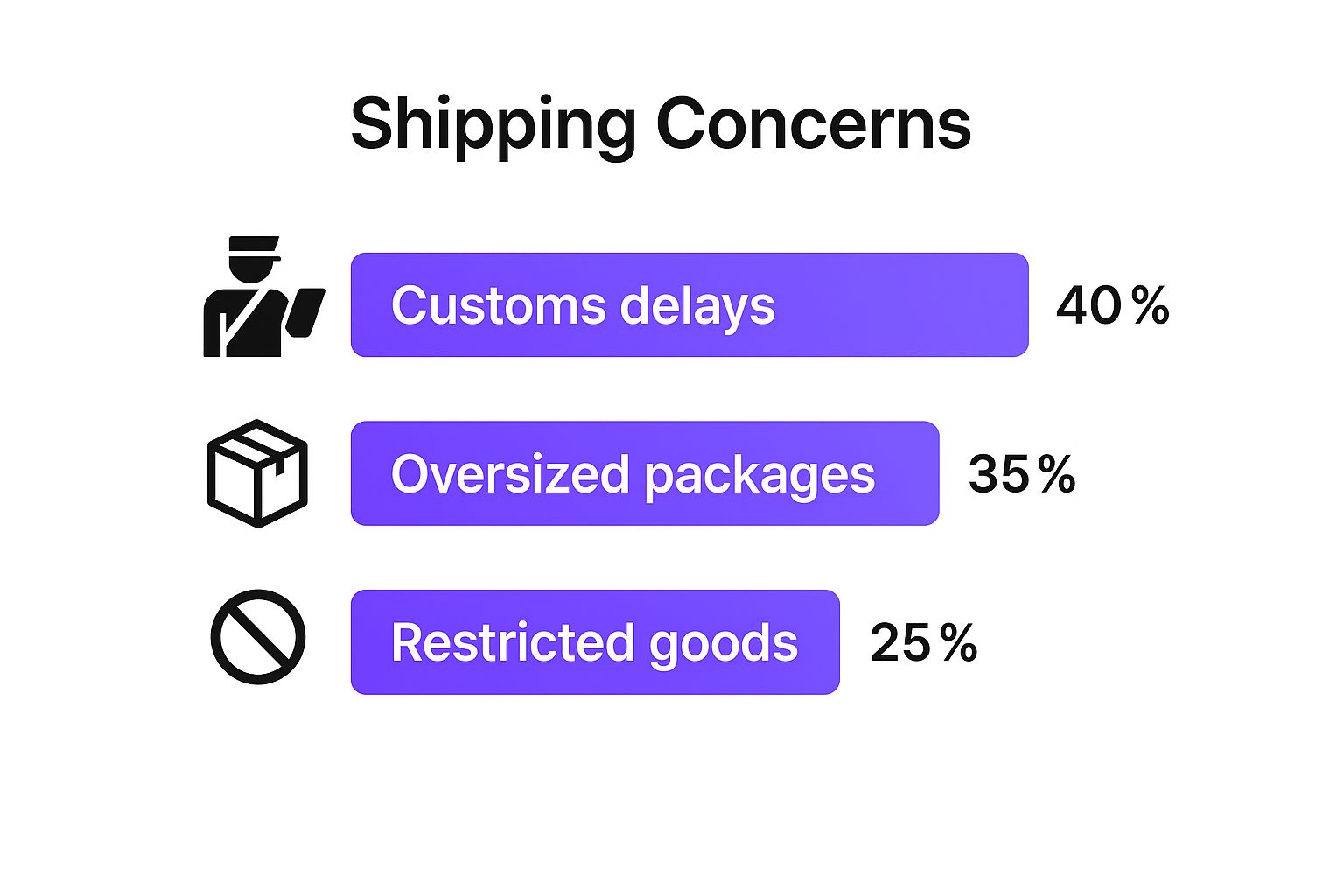
Customer Service Scripts for Explaining Shipping Restrictions: Tips & Templates
Learn effective Customer Service Scripts for Explaining Shipping Restrictions to handle questions confidently and boost customer satisfaction. Get started now!
Cody Y.
Updated on Oct 4, 2025
When a customer calls about a shipping delay, the last thing they want is a robotic, canned response. Using the right customer service scripts for explaining shipping restrictions can be the difference between turning a frustrated customer into a loyal one and escalating a minor issue into a major complaint.
Why Standard Shipping Scripts Fail Customers

The biggest problem with most pre-written scripts is that they completely lack empathy and transparency. When an order is delayed, a customer isn't just seeking information—they're looking for reassurance that someone is taking their problem seriously. A generic "we apologize for the inconvenience" just feels dismissive. It's impersonal and, frankly, it makes things worse.
Truly effective communication goes way beyond those tired old phrases. It’s about shifting your team's mindset from simply passing along information to actively solving a problem and managing the customer's emotions. This guide will help you craft scripts that actually build trust, even when you have to deliver bad news.
The Psychology Behind a Delayed Order
When someone clicks "buy," they're entering into a mental contract with you. They expect their product to show up on time and exactly as described. Any hiccup in that process creates friction and anxiety. This is precisely where a good script proves its worth.
- Acknowledge Their Frustration: The very first step is to validate how they feel. A simple, "I can absolutely see why this is frustrating for you" immediately shows you're on their side.
- Give a Clear Reason: Vague excuses like "operational delays" are infuriating for a customer. You have to be specific without getting bogged down in technical jargon. Helping your team understand the different types of shipping restrictions allows them to provide real, accurate context.
- Offer a Real Solution: More than anything, the customer wants to know what's next. A great script always pivots from the problem to the solution, empowering your agent to take immediate, helpful action.
A well-crafted script isn't a cage; it's a framework. It provides the essential information and empathetic language your team needs, while giving them the flexibility to personalize the conversation and create a genuine connection.
By focusing on transparency, empathy, and clear solutions, your scripts stop being a corporate shield and start becoming a powerful tool for customer retention.
Navigating Geopolitical and Route Disruptions
When a major global event throws a wrench in the supply chain, your customers need straight answers, not vague corporate-speak. This is where having a solid customer service script for explaining shipping disruptions becomes essential—one that’s both empathetic and fact-based.
Your first move should always be to acknowledge the customer's completely justified concern. Then, immediately give them the real context.
Let’s say a customer calls about a package that’s taking way longer than promised. Instead of a generic "we're experiencing delays," you can empower your agent to be transparent.
A much better response sounds something like this: "I completely understand your frustration with this delay, and I want to explain exactly what’s happening. There’s a major disruption on the primary sea route affecting shipments globally, so your package has been rerouted to ensure its safety."
This small shift in approach builds a massive amount of trust. You're treating the customer like a partner in the situation, not just another ticket number.
Explaining the 'Why' Behind the Wait
Going a step further means explaining the direct impact on their order. For instance, since early 2024, significant disruptions in the Red Sea have forced carriers to divert ships all the way around Africa.
This detour adds about 3,000 nautical miles and up to 12 days to transit times, which directly impacts both operational costs and delivery schedules. Sharing this kind of specific detail helps customers see the issue is external and not an internal failure on your part. You can get more background on these kinds of ongoing supply chain risks for shippers at WTAGroup.com.
When you're building a script to handle these tough conversations, it helps to break it down into a few key components. Each piece has a specific job to do, moving the conversation from a problem to a manageable situation.
Key Components for a Geopolitical Disruption Script
This table breaks down the essential elements of a script for explaining delays from external geopolitical events, with practical phrase examples for each.
| Script Component | Purpose | Example Phrase |
|---|---|---|
| Acknowledge & Empathize | Validate the customer's feeling of frustration. | "I can see this is taking longer than you expected, and I want to apologize for the delay." |
| Provide Clear Context | Explain the external event in simple terms. | "Due to a necessary change in global shipping lanes, many carriers are using longer routes." |
| State the Impact | Connect the event to their specific order. | "This means your delivery timeframe has been extended, but I can confirm it's still safely in transit." |
| Offer a Proactive Solution | Give them a next step or tangible action. | "I've enabled enhanced tracking notifications for you, so you'll get real-time updates." |
Ultimately, having a script like this equips your team to handle difficult external events with confidence and transparency.
The goal is to reframe the conversation from "your package is late" to "here is what's happening in the world and how we are managing it for you." This proactive stance turns a potentially negative interaction into an opportunity to demonstrate your company's commitment and reliability, even when facing circumstances beyond your control.
Explaining Complex Regulatory and Eco-Policies

Customers don't see the complex web of environmental rules that dictate how global shipping operates, but they definitely feel the sting when a package gets delayed. Talking about these policies is a delicate dance—you have to be transparent without sounding like you're making excuses.
The trick is to frame these changes as a positive, industry-wide shift toward sustainability, not a problem unique to your company. Your customer service scripts need to be clear, confident, and reassuring.
For example, when a customer inevitably asks about a new "eco-surcharge," your team needs to be ready. The script should explain it's a direct result of new, tougher emissions standards that every single carrier has to follow.
Instead of a blunt, "We have a new fee," try a more educational approach: "To meet new global environmental standards, the entire shipping industry is adapting. This involves new costs for greener fuel and technology, which allows us to continue shipping your products responsibly."
This shifts the conversation. You're not just explaining a fee; you're educating the customer and positioning your brand as a conscientious partner in a global effort.
Crafting Scripts for Sustainability Questions
To handle these conversations well, your customer service team needs some background knowledge. Having them review a comprehensive guide to carbon footprint tracking in logistics can help them speak confidently about what's changing in the industry.
For instance, new mandates from the International Maritime Organization (IMO) are pushing the entire sector toward net-zero emissions. This is forcing carriers to switch to cleaner—but much more expensive—alternative fuels.
This transition can increase operating costs and even affect how many vessels are available, which in turn impacts both shipping speeds and prices. When a customer notices these changes, your script's job is to connect the dots. It should clarify that schedule shifts or new fees are often because of regulatory compliance and fleet-wide upgrades, not an internal service failure on your part.
A solid script should cover these bases:
- Acknowledge their question about the fee or delay right away.
- Explain the "why" in simple terms, focusing on the positive environmental goal.
- Reassure them this is an industry-wide change for a greener future.
- Bring it back to their order and confirm it’s being handled with care.
This strategy turns a potential complaint into a chance to reinforce your brand’s values and show your commitment to doing business the right way.
Sometimes, the delay has nothing to do with your warehouse or your team.
Issues like port congestion, carrier labor shortages, and wider economic pressures can bring a perfectly packed order to a screeching halt. When that happens, customers are left confused and frustrated, and your team is on the front line.
Your agents need scripts that empower them to explain these external factors with confidence. This isn't about making excuses; it's about providing crucial context that helps customers understand the bigger picture and transforms a negative situation into a moment of trust-building transparency.
Crafting Scripts for External Carrier Issues
An effective script helps your team explain that while your company fulfilled the order on time, it's now caught in an industry-wide slowdown. This requires a subtle but important shift from apology to explanation.
Here’s a great example: "I can see your order was dispatched from our facility right on schedule, but it's currently held up due to significant congestion at the main shipping hub. We're monitoring it closely and will notify you the moment it starts moving again."
The infographic below shows some of the most common reasons for these kinds of delays.

As you can see, issues like customs hold-ups (40%) and oversized packages (35%) make up a huge portion of delays. These are external factors that proactive communication can help clarify for your customers.
Weaving Economic Context into Your Scripts
Beyond carrier logistics, broader economic factors also play a massive role. According to recent maritime transport reviews, global seabornetrade is expected to see almost no growth, with projections at a mere +0.5%.
This stagnation is happening while ships are forced into longer routes, increasing both transit times and fuel costs.
By explaining these realities, you help customers see delays as part of broader supply chain volatility, not just a service failure on your part. You can read more about these global shipping industry challenges at GCaptain.com.
For businesses that need to manage complex shipping rules consistently, learning about automated shipping compliance for WooCommerce stores can provide a solid foundation for handling these restrictions systematically and transparently.
Getting ahead of these issues is always better than waiting for the customer to complain. The difference in customer perception is night and day.
How Proactive vs Reactive Communication Shapes Customer Experience
| Aspect | Proactive Approach | Reactive Approach |
|---|---|---|
| Customer Perception | "They're on top of it and keeping me informed." | "Why didn't they tell me? I had to chase them down." |
| Trust & Credibility | Builds trust through transparency and honesty. | Erodes trust; feels like hiding bad news. |
| Support Team Workload | Reduces inbound tickets by answering questions early. | Increases ticket volume with frustrated customer inquiries. |
| Resolution Time | Solves the information problem instantly. | Lengthens resolution time with back-and-forth emails. |
| Customer Emotion | Fosters understanding and patience. | Creates anger, frustration, and anxiety. |
Ultimately, a proactive message turns a potential problem into proof that you're watching out for your customers, while a reactive response just confirms their frustration.
The most powerful customer service scripts for explaining shipping restrictions are built on proactive transparency. When you arm your team with clear, factual information about external delays, you build credibility and reduce repeat support inquiries, even when the news isn't what the customer wants to hear.
Putting Your New Scripts Into Action

So you've crafted the perfect customer service scripts for explaining shipping restrictions. That's a huge step, but it's only half the battle. The real magic happens when these scripts become a natural, flexible part of your team's daily flow, not just a rigid mandate that makes conversations feel robotic.
True success starts with solid training. Don't just hand over a document and call it a day. Get your agents engaged with active learning, like role-playing different scenarios. Walk them through everything from a simple carrier delay to a tricky regulatory issue. This kind of practice helps your team internalize the key talking points and deliver them with genuine confidence.
It's also about empowerment. Encourage your agents to adapt the language to fit their own conversational style and mirror the customer's tone. That personal touch is what elevates a support interaction from just "good" to truly memorable.
Integrating Scripts and Gathering Feedback
To make life easier for your team, bake these scripts right into your CRM or helpdesk software. By using text snippets or macros, agents can pull up the right framework with a simple command. This keeps your messaging consistent without slowing anyone down. It's especially useful for complex situations, like when you need to handle split orders when some products can’t ship together.
If you’re ready to take your communication strategy to the next level, it's worth exploring the more technical side of support. There are some great guides on how to automate your customer service that can help ensure your new scripts are delivered as efficiently as possible.
The most effective scripts are living documents. They should evolve based on real-world feedback from both your customers and your support agents.
Finally, you need to establish a continuous feedback loop. Set up regular check-ins with your team to talk about what’s working and what isn’t. This collaborative approach ensures your scripts stay relevant, genuinely helpful, and perfectly aligned with your goal: turning tough situations into opportunities to build lasting customer trust.
Your Top Questions About Shipping Scripts, Answered
<iframe width="100%" style="aspect-ratio: 16 / 9;" src="https://www.youtube.com/embed/CojS0DwflXc" frameborder="0" allow="autoplay; encrypted-media" allowfullscreen></iframe>When you're building out scripts for tricky situations like shipping restrictions, a few questions always pop up. Getting these right is the key to empowering your team to handle tough customer conversations with skill and confidence. Let's walk through the most common ones.
One of the biggest concerns I hear is about scripts sounding robotic. Nobody wants their support team to sound like a machine. The secret is to treat your scripts as flexible frameworks, not word-for-word mandates.
Think in terms of bullet points, not paragraphs. Give your agents the critical information—the 'what' and 'why' of the delay—and let them use their own words to deliver it. This simple shift allows their natural empathy and personality to shine through.
Regular role-playing sessions are also a huge help here. It’s one thing to read a script; it’s another to practice delivering it conversationally until it feels natural.
How Do You Deliver Bad News Effectively?
When you have to tell a customer their order is delayed, a structured approach is your best friend. Many seasoned support managers (myself included) swear by the 'empathy sandwich' technique for these delicate conversations.
It’s a simple, three-part flow:
- Start with Empathy: Always begin by acknowledging how the customer feels. A simple, "I can imagine this is frustrating news, and I’m sorry for the delay," immediately validates their feelings.
- State the Facts Clearly: Next, deliver the news directly and honestly, explaining the external cause. For example, "Your package is being held up due to unexpected congestion at the port." No sugarcoating, just the facts.
- Pivot to a Solution: End the conversation by focusing on what you can do. "What I can do for you right now is..." immediately shows you’re on their side and actively working to help.
This method confirms their feelings, gives them the necessary context, and keeps the conversation moving toward a productive resolution.
Should We Proactively Notify Customers About Delays?
Absolutely. 100% yes. Proactive communication is a total game-changer for building customer trust.
If you know a batch of orders is going to be impacted by an issue, sending out a notification before customers start asking questions shows you're on top of it. This one action can transform a potentially negative experience into a moment that actually strengthens their loyalty to your brand. Plus, it drastically cuts down on the number of inbound support tickets your team has to handle.
Finally, a quick tip: keep the technical details simple. Your customers don't need a lesson in logistics. Instead of saying something technical like, "due to vessel rerouting," try a simpler explanation like, "due to a necessary change in the shipping route to avoid disruptions." The goal is to give just enough context for the delay to make sense, then bring it right back to what it means for their order.
Ship Restrict simplifies complex shipping compliance directly within your WooCommerce store. By automatically enforcing rules by state, ZIP code, or city, you can eliminate costly shipping mistakes and save hours of manual work. Learn how to automate your shipping restrictions and protect your business.

Cody Yurk
Founder and Lead Developer of ShipRestrict, helping e-commerce businesses navigate complex shipping regulations for regulated products. Ecommerce store owner turned developer.